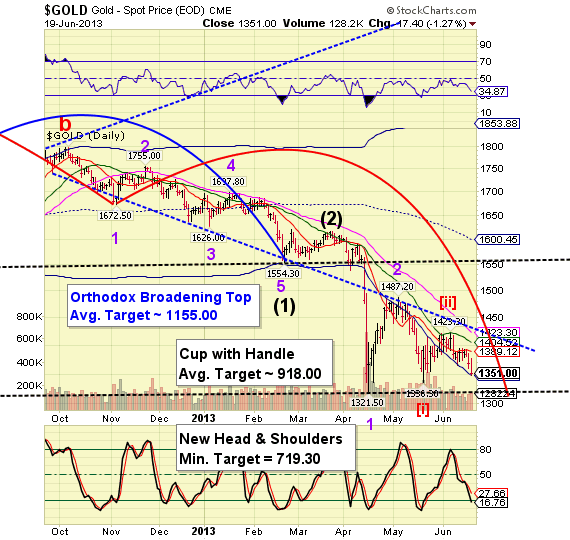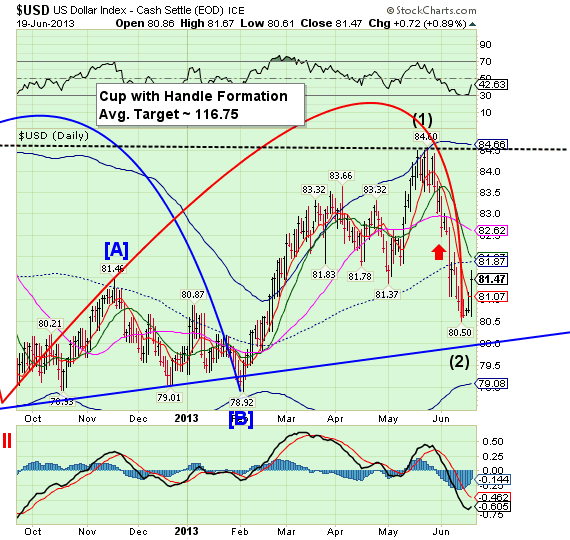By Jack Scoville
COCOA
General Comments: Futures closed lower as the U.S. dollar rallied. Fears of an economic slowdown created by Fed tapering of the QE program created selling in all commodities yesterday. There was not a lot of news for the market, and price action reflected this. Ideas of weak demand after the recent big rally kept some selling interest around. The weather is good in West Africa, with more moderate temperatures and some rains. The mid-crop harvest is about over, and less than expected production along with smaller beans is reported. Malaysia and Indonesia crops appear to be in good condition and weather is called favorable.
Overnight News: Scattered showers are expected in West Africa. Temperatures will average near to above normal. Malaysia and Indonesia should see episodes of isolated showers. Temperatures should average near normal. Brazil will get mostly dry conditions and warm temperatures. ICE certified stocks are lower today at 5.033 million bags. ICE said that 0 delivery notices were posted today and that total deliveries for the month are 120 contracts.
Chart Trends: Trends in New York are down with no objectives. Support is at 2140, 2105, and 2080 September, with resistance at 2200, 2230, and 2250 September. Trends in London are down with objectives of 1380 and 1270 September. Support is at 1430, 1360, and 1320 September, with resistance at 1450, 1470, and 1490 September.
COTTON
General Comments: Futures were lower again on what appeared to be long liquidation from speculators and perhaps some farm selling. The Sharp rally in the US Dollar and disappointing economic news from China caused the selling interest to develop. Export sales were less, adding to selling interest. Ideas of better weather in US production areas were once again negative for prices. Some storms are moving through western Texas and conditions there are improving. Good weather is being reported in the Delta and Southeast as well. The weather has improved, and looks to improve conditions generally through the rest of the week. Scattered showers are forecast for the Delta and Southeast, and wetter and warm weather is expected in Texas. Weather for Cotton appears good in India, Pakistan, and China. It is possible that futures made at least a short term high on Friday.
Overnight News: The Delta and Southeast will see some showers this weekend. Temperatures will average above normal. Texas will get showers today, then dry weather. Temperatures will average above normal. The USDA spot price is now 81.34 ct/lb. ICE said that certified Cotton stocks are now 0.562 million bales, from 0.550 million yesterday.
Chart Trends: Trends in Cotton are down with no objectives. Support is at 85.15, 84.75, and 84.55 October, with resistance of 87.10, 88.20, and 89.60 October.
FCOJ
General Comments: Futures closed slightly lower, but held support near 1540.00 in the nearby contract. Futures have been working generally lower as showers have been seen and conditions are said to have improved in almost the entire state. Ideas are that the better precipitation will help trees fight the greening disease. Traders are wrestling with more reports of losses from greening disease on the one side and beneficial rains that have hit the state on the other. Greening disease and what it might mean to production prospects continues to be a primary support item and will be for several years. Temperatures are warm in the state, but there are showers reported somewhere in the state every day now. The Valencia harvest is continuing. Brazil is seeing near to above normal temperatures and mostly dry weather, but showers are possible next week.
Overnight News: Florida weather forecasts call for showers. Temperatures will average near to above normal.
Chart Trends: Trends in FCOJ are down with objectives of 141.00, 133.00, and 130.00 July. Support is at 142.00, 139.00, and 137.50 July, with resistance at 145.00, 146.50, and 150.00 July.
COFFEE
General Comments: Futures were sharply lower as the Real fell and the US Dollar rallied on the Fed announcements and some weak economic data from China. It was a bad day as trends in all three markets turned back down. However, futures also got to or closet o the final down side objectives for the down trend, so it is possible that the market can rally going into the weekend. Arabica cash markets remain quiet right now and Robusta selling interest has become less, as well. Most sellers, including Brazil, are quiet and are waiting for futures to move higher. Buyers are interested on cheap differentials, and might start to force the issue if prices hold and start to move higher in the short term. Brazil weather is forecast to show dry conditions, but no cold weather. There are some forecasts for cold weather to develop in Brazil early next week, but so far the market is not concerned. Current crop development is still good this year in Brazil. Central America crops are seeing good rains now. Colombia is reported to have good conditions.
Overnight News: Certified stocks are little changed today and are about 2.748 million bags. The ICO composite price is now 113.37 ct/lb. Brazil should get dry weather except for some showers in the southwest on Sunday. All areas could get showers early next week. Temperatures will average near to above normal. Colombia should get scattered showers, and Central America and Mexico should get showers, with some big rains possible in central and southern Mexico and northern Central America. Temperatures should average near to above normal. ICE said that 132 delivery notices were posted against July today and that total deliveries for the month are now 666 contracts.
Chart Trends: Trends in New York are down with no objectives. Support is at 116.00, 113.00, and 110.00 September, and resistance is at 122.00, 123.50, and 125.00 September. Trends in London are mixed to down with objectives of 1670 and 1580 September. Support is at 1705, 1680, and 1650 September, and resistance is at 1755, 1775, and 1800 September. Trends in Sao Paulo are down with no objectives. Support is at 140.00, 137.00, and 134.00 September, and resistance is at 148.00, 151.00, and 155.00 September.
SUGAR
General Comments: Futures closed sharply lower on strength in the US Dollar and weakness in the Brazilian Real, combined with disappointing economic news from China. Trends flipped to down with the price action yesterday, and some follow through selling is possible on Friday or early next week. Traders remain bearish on ideas of big supplies, especially from Brazil. Traders in Brazil expect big production as the weather is good. Demand is said to be strong from North Africa and the Middle East. ICE said that a Sugar storage facility in Paranagua, Brazil, was damaged by fire this week and that deliveries could be affected.
Overnight News: Showers are expected in Brazil, mostly in the south and southwest late this weekend and in all areas next week. Temperatures should average near to above normal.
Chart Trends: Trends in New York are mixed to down with objectives of 1640 and 1580 October. Support is at 1665, 1650, and 1620 October, and resistance is at 1700, 1720, and 1730 October. Trends in London are mixed to down with objectives of 458.00 and 441.00 October. Support is at 469.00, 466.00, and 463.00 October, and resistance is at 475.00, 480.00, and 484.00 October.
See the original article >>










































